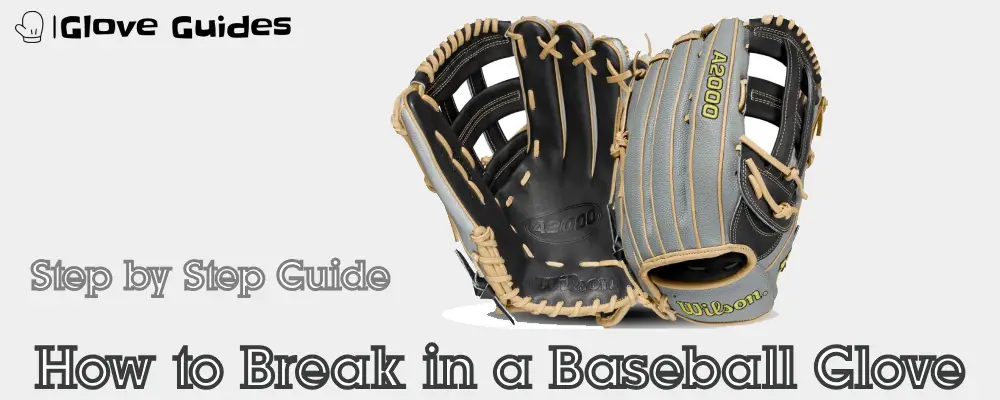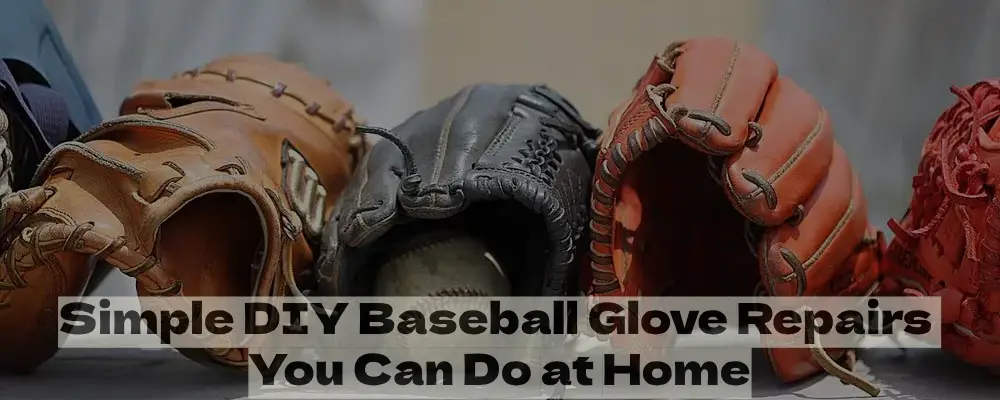
Stepping onto the baseball field, ready to play your best, you need the perfect glove. It’s like your helping hand, helping you catch balls. But picking one can be confusing with all the different sizes and types.
Don’t worry! This guide will help. We’ll explain everything about gloves, so you can choose the right baseball glove by position and playing style. From understanding sizes to knowing what web type is best, you’ll become a glove pro in no time. Get ready to step up your game and catch every ball like a champ!
Choosing The Baseball Glove by Position and Playing Style
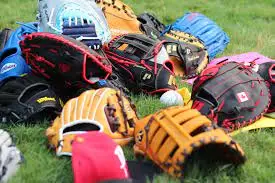
1. Understanding Your Position and Playing Style
Choosing the right baseball glove isn’t just about finding your favorite color or brand. It’s about finding the perfect partner in crime, the extension of your hand that transforms hot liners into outs and screaming fly balls into souvenirs.
But before you get swept away by flashy designs and fancy logos, take a moment to understand your true baseball identity: Your position and playing style.
Different positions demand different glove traits. Think of it like a superhero suit. A second baseman needs the agility of Spider-Man, while an outfielder craves the soaring grace of Superman. Let’s break down the ideal glove characteristics for each hero of the diamond:
A. Glove Size Recommendations by Position
| Position | Size Range (inches) | Ideal Web Types | Key Features |
| Second Baseman | 11-11.5 | Open Webs (I-web, H-web) | Compact, Agile, Quick Transfers |
| Shortstop | 11.5-11.75 | Shallow Pocket, Open Webs | Range, Flexibility, Fast Reactions |
| Third Baseman | 12-13 | Open Webs (Modified webs), Deeper Pockets | Versatility, Hot Corner Scoops, Ball Control |
| Outfielder | 12.5-13.5 | Closed Webs (Double T-web, Basket Web) | Deep Pockets, Maximum Reach, Secure Catches |
| First Baseman | 12-14 | Large Mitt, Deep Pocket | Ball Scooping, Fielding Control, Throwing Defense |
Now, let’s explore deeper into these glove heroes:
- Second Baseman: Think quick feet and lightning-fast reflexes. Your glove should be your trusty sidekick, compact and nimble for those acrobatic double plays. Open webs like the I-web or H-web offer visibility and quick ball release for those lightning-fast transfers.
- Shortstop: You’re the captain of the infield, the puppet master controlling the flow of the game. Your glove needs range and flexibility, a slightly larger size to snag those rockets that hit your way. Shallow pockets prioritize rapid transfers, ensuring you keep the runners grounded.
- Third Baseman: The hot corner’s your domain, and your glove needs to be tough as nails. A longer size tackles those grounders singing off the bat, while a deeper pocket cradles hard-hit balls like a catcher’s mitt. Open webs like the modified trap give you versatility to handle any scorcher coming your way.
- Outfielders: Soaring through the air like Superman, you need a glove that’s an extension of your wings. Extra length maximizes your reach, deep pockets cradle fly balls like precious gems, and closed webs ensure those soaring catches never slip through your grasp. Corner outfielders, consider specialized gloves with even deeper pockets and reinforced padding for those extra-deep dives.
- First Baseman: The anchor of the infield, your glove is your trusty shield. Size matters here, a large mitt scoops up grounders like a dustpan, while a deep pocket keeps throws from bouncing out. Remember, ball control is your superpower, so choose a glove that feels like a natural extension of your hand.
B. Playing Style
Beyond your designated position on the diamond, your individual playing style is a crucial factor in choosing the perfect glove. This isn’t just about flashy plays or quiet confidence – it’s about understanding your natural tendencies and how they translate into fielding choices. So, let’s dive into the two main aspects of playing style: aggressive vs. defensive and power hitter vs. contact hitter.
i. Aggressive vs. Defensive:
Think of yourself as a fielding chess player, constantly adapting to the game’s flow. Are you a quick-twitch predator, always aiming to steal outs with daring dives and acrobatic catches? Or are you a stalwart sentinel, prioritizing control and reliability, ensuring every ball finds its way into your leather embrace?
| Playing Style | Web Type Preference | Pocket Depth Preference |
| Aggressive | Open Webs (I-web, H-web) | Shallow Pocket |
| Defensive | Closed Webs (Double T-web, Basket Web) | Deeper Pocket |
Why this matters:
- Open webs: Offer superior visibility for quick reactions and fast transfers, perfect for aggressive players looking to turn double plays in a blink.
- Closed webs: Cradle the ball more securely, ideal for defensive players who prioritize ball control and minimizing pop-outs.
- Shallow pockets: Allow for quicker glove-to-hand transfers, crucial for aggressive plays like diving catches.
- Deeper pockets: Provide better ball control and prevent grounders from bouncing out, ideal for defensive players who prioritize scooping up tough hops.
ii. Power Hitter vs. Contact Hitter:
Now, let’s switch gears to the offensive side. Are you a slugger, crushing homers with thunderous swings, or a maestro of the bat, peppering the field with line drives and grounders? This distinction has subtle implications for your outfield glove choice.
| Playing Style | Glove Size Preference |
| Power Hitter | Slightly smaller glove (12.5-13 inches) |
| Contact Hitter | Contact Hitter |
Why this matters:
- Power hitters: With strong throws, a slightly smaller glove can facilitate faster transfers from glove to hand, maximizing arm speed and accuracy.
- Contact hitters: Maintaining a standard outfield glove size ensures sufficient reach for those unexpected fly balls while still allowing for comfortable throws.
iii. Expert Tips:
- Consider practicing fielding drills with different glove sizes and web types to see what feels most natural.
- Ask experienced players or coaches for advice on choosing the right glove for your style.
- Don’t be afraid to break the mold! Some players mix and match styles, finding success with unexpected glove combinations.
2. Choosing the Right Glove Size and Fit
When choosing a baseball glove, size, throwing hand, and fit are the three factors that matter most, regardless of whether you’re a t-ball player, a youth league star, or an adult looking to reignite your love for the game.
A. Youth Baseball Glove Size Chart
| Position | Up To 5 Years Old | 6-7 Years Old | 8-10 Years Old | 11-12 Years Old |
| Indielder | 8” – 10.5” | 8” – 10.5” | 10” – 11.5” | 11” – 12” |
| Outfielder | 9″ – 10.5″ | 9″ – 10.5″ | 10″ – 11.5″ | 11″ – 12″ |
| Pitcher | 8” – 10.5″ | 8” – 10.5″ | 10.5″ – 11″ | 11″ – 12″ |
| Catcher | 29.5″ – 30″ | 29.5″ – 30″ | 30″ – 32″ | 30″ – 32.5″ |
| First Base | 11.5” | 11.5” | 11.5″ – 12″ | 11.5″ – 12″ |
B. Adult Baseball Glove Size Chart
| Position | 13-14 Years Old | High School & College Ages |
| Indielder | 11″ – 12″ | 11″ – 12.25″ |
| Outfielder | 11.75″ – 12.75″ | 12.5″ – 12.75″ |
| Pitcher | 11.5” – 12″ | 11.5″ – 12.5″ |
| Catcher | 30″ – 32.5″ | 32.5″ – 34″ |
| First Base | 11.5” -12″ | 12” – 13″ |
3. What Baseball Glove Size Do I Require?

Finding the perfect baseball glove size is crucial for optimal performance and comfort. Your ideal size depends on three main factors:
- Age: Glove sizes typically range from 8.5″ for young children to 14″ for adult slow-pitch softball players. Use the following as a general guideline:
- Hand Size: Measure the distance from the tip of your middle finger to the base of your palm (wrist crease) to determine hand size. Compare your measurement to the manufacturer’s size chart for the specific glove model you’re interested in.
Position:
Different positions require slightly different glove sizes for optimal performance:
- Infielders: Smaller gloves for quick transfers and agility.
- Outfielders: Larger gloves for maximum reach and fly ball tracking.
- First Basemen: Wide mitts for scooping grounders and fielding throws.
Remember, size charts are just a starting point. The most important factor is how the glove actually feels on your hand.
3.i. How Should a Baseball Glove Fit?
A good baseball glove should be snug but not constricting. Here’s how to check the fit:
- Closed Glove: With one hand, close the glove around your dominant hand. Your fingers should fit comfortably without feeling cramped.
- Thumb Reach: Extend your thumb across the palm. It should barely touch the tip of your pinkie finger.
- Finger Movement: Flex and spread your fingers freely within the glove.
3.ii. Breaking In Your Glove:
New gloves are stiff, so it’s important to break them in for maximum comfort and performance. Here are some tips:
- Play with it: The best way to break in a glove is to use it. Catching, throwing, and fielding will gradually soften the leather and make it more flexible.
- Apply oil: A light coat of leather conditioner can help soften the material and prevent cracking.
- Heat it up: Sitting in a warm car for a few hours can help loosen up the leather.
3.iii. Size Up or Size Down?
Size Up:
- If your fingertips stick out significantly or the glove feels constricting.
- If you’re a growing youth player or prefer a slightly deeper pocket.
Size Down:
- If the glove feels bulky or hinders your hand movement.
- If you’re an infielder who prioritizes quick transfers and agility.
Expert Tip: Choosing the right glove size is an investment in your performance and enjoyment of the game. Don’t hesitate to try on different models and sizes before making a decision.
4. Web Types and Their Benefits
Choosing the right web type is like picking the perfect partner for your glove – it defines how you interact with the ball, shaping your defensive style. Let’s explore the web’s of wisdom and find the ideal match for your position:
4.i. Open Web:
Popular among infielders, these webs, like the classic I-web and its sturdy cousin, the H-web, let the ball flash through with minimal obstruction. Think quick throws and slick double plays – perfect for those who live by the motto “speed kills.”
4.ii. Closed Web:
Outfielders, the guardians of the vast green pasture, demand a different kind of ally. Enter the closed web, a fortress of leather that cradles the ball securely. Picture diving catches and laser-focused throws – webs like the Double T-web and the Basket Web offer ultimate control and protection, ensuring no fly ball escapes your grasp.
4.iii. Beyond the Classics:
But the world of webs doesn’t end there. Modified Trapeze, with its deep pocket and added stability, offers outfielders flexibility, while the Single/Double Post provides infielders a balance of visibility and control. Don’t be afraid to explore these hidden gems – you might just unearth your perfect glove soulmate.
5. Baseball Glove Types according to Position
The kinds of glove webs we suggest differ according to the position, much like baseball gloves come in different sizes! A multifunctional glove can help the youngster learn and practice multiple positions if you’re new to the game or shopping for youth baseball and are unclear of the precise field position to buy for.
A. Baseball Glove Web Types for Infielders
Smaller, five-fingered designs with shallow pockets are common in infield gloves, allowing for rapid transitions from the glove to the throwing hand. It will be simple to pick up ground balls by sifting through dirt using smaller gloves that have larger webbing.
The following gloves are beneficial for most infielders, but you should try a few different ones according to your position, playing style, and other preferences. Third basemen, for instance, could favor close webbing since they frequently field powerful hits, which call for greater strength and support.
i. H-Web:
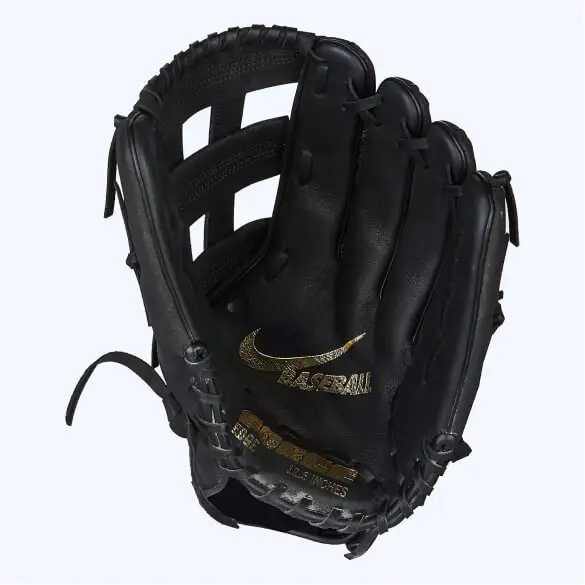
The H-web, with its clean lines and sturdy H-shaped construction, is an infield mainstay. Its open design lets you whip the ball out like a gunslinger after snagging it, making it a favorite for quick-handed shortstops and second basemen.
Pros:
- Superb stability and control: The strong H-pattern cradles the ball securely, even with hard-hit liners.
- Fast transfers: The open web allows for a quick release from glove to hand, ideal for lightning-fast double plays.
- Classic, timeless look: This iconic web exudes a timeless elegance that never goes out of style.
Cons:
- Less forgiving for beginners: The smaller pocket can be tricky for young players or those still mastering their fielding technique.
- Not ideal for deep scoops: The open design might not offer enough depth for scooping balls thrown low from first base.
ii. I-Web:

The I-web, with its bold “I” formation, is a jack-of-all-trades for the infield. It blends the stability of a closed web with the quick transferability of an open one, making it a chameleon extraordinaire. Think third basemen diving for hot corners or second basemen snagging line drives – the I-web handles it all with panache.
Pros:
- Versatile performance: Handles a wide range of grounders and throws with ease.
- Good pocket depth: Offers enough security for deep scoops and first base throws.
- Relatively forgiving for beginners: The larger pocket provides more margin for error than the H-web.
Cons:
- Not as stable as the H-web: The open design might not offer the same level of control for hard-hit balls.
- Slightly slower transfers: The deeper pocket can add a fraction of a second to the transfer time compared to the H-web.
iii. Modified Trapeze
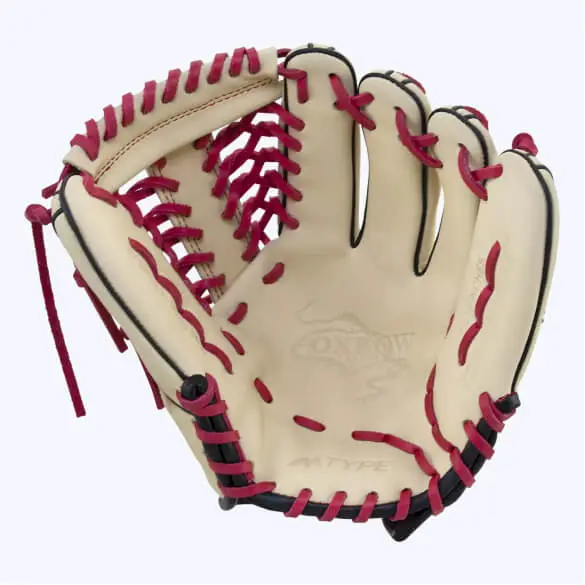
The modified trapeze, with its extra leather strap and deep pocket, is the Fort Knox of infield gloves. It’s designed for those who value impregnable defense over lightning-fast throws. Think first basemen guarding the bag like a dragon guarding its hoard, or third basemen scooping throws from across the diamond with unwavering confidence.
Pros:
- Good pocket depth: Catches even the lowest throws and grounders with ease.
- Superior ball control: The deep pocket and closed web keep the ball secure, even during collisions or dives.
- Great for first basemen and deep corner infielders: Provides the perfect combination of reach and control for these positions.
Cons:
- Slowest transfers: The deep pocket can significantly slow down the transfer time compared to other webs.
- Less forgiving for beginners: The bulky design can be cumbersome for younger players or those with smaller hands.
- Not ideal for quick plays: The closed web might not be the best choice for situations requiring rapid throws.
iv. Single/Double Post
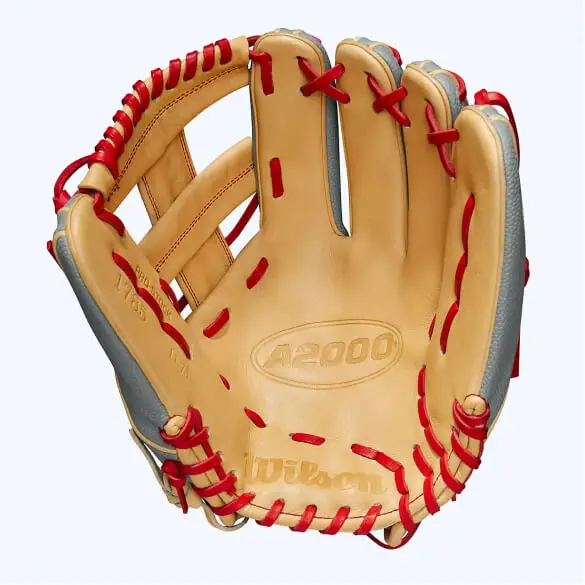
The single/double post web, with its simple crossbar design, might not be the flashiest glove on the block, but it packs a punch. It’s lightweight and flexible, making it a favorite for younger players or those who prioritize agility and quick throws. Think second basemen zipping around the infield or shortstops turning double plays with lightning speed.
Pros:
- Open web for fast transfers: The single/double post web allows for a speedy release from glove to hand, perfect for turning double plays in a blink.
- Great for beginners: The forgiving design and open web make it easier to catch grounders and throws, boosting confidence on the field.
- Affordable option: Often more budget-friendly than other web types, making it a great choice for families or recreational players.
Cons:
- Less control for hard-hit balls: The open web might not offer the same level of stability and control as closed webs for screaming liners.
- Not ideal for deep scoops: The shallow pocket might not be enough for scooping throws from across the diamond or snagging low-flying grounders.
- Limited versatility: Primarily suited for quick throws and infield agility, not as effective for deep scoops or first base play.
B. Baseball Glove Web Types for Outfielders
Are you curious about the greatest strategies an outfielder may employ to secure those fly balls? Baseball outfield gloves are often longer, giving the player more reach and a deeper pocket to hold onto catches. For added security, most outfielders will choose closed webbing.
i. H-Web (or Dual Post)
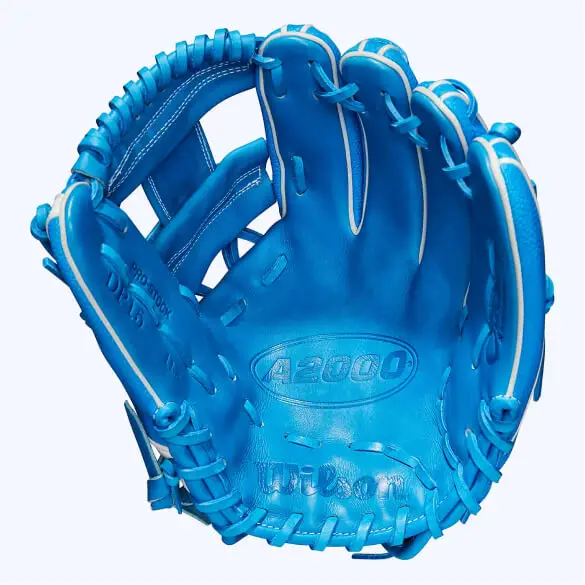
The H-web, with its sturdy H-shaped construction, is a wall against the wind, a force field against errant throws and screaming line drives. Its deep pocket swallows up fly balls like a hungry whale, while the open web allows for lightning-fast transfers to your throwing hand.
Pros:
- Control and stability: The strong H-pattern and deep pocket keep the ball secure, even during collisions or dives.
- Fast transfers: The open web lets you get the ball out of your glove and into your hand in a flash.
- Great for all outfield positions: From center field generals to corner wallflowers, the H-web offers versatility and confidence.
Cons:
- Slightly heavier than some other webs: The extra leather can be a bit cumbersome for younger players or those who prioritize agility.
- Less forgiving for beginners: The smaller pocket might require more practice for mastering clean catches.
ii. Modified Trapeze

For those who believe in catching everything but the wind, there’s the modified trapeze. With its extra leather strap and bottomless pit of a pocket, it is like a vacuum cleaner for baseballs. Perfect for center fielders who patrol the vast expanse, or corner outfielders who need to corral balls bouncing off the walls.
Pros:
- Depth and security: No fly ball is safe from this cavernous pocket.
- Superior control: The closed web keeps the ball snug, even during wild throws or windy conditions.
- Great for first basemen and deep corner outfielders: The extra reach and control make it ideal for these positions.
Cons:
- Slowest transfers: The deep pocket can significantly slow down the transfer time compared to other webs.
- Bulky and heavy: Not the best choice for younger players or those who prioritize agility.
- Less forgiving for beginners: The closed web might not be the best choice for situations requiring rapid throws.
iii. Basket Web
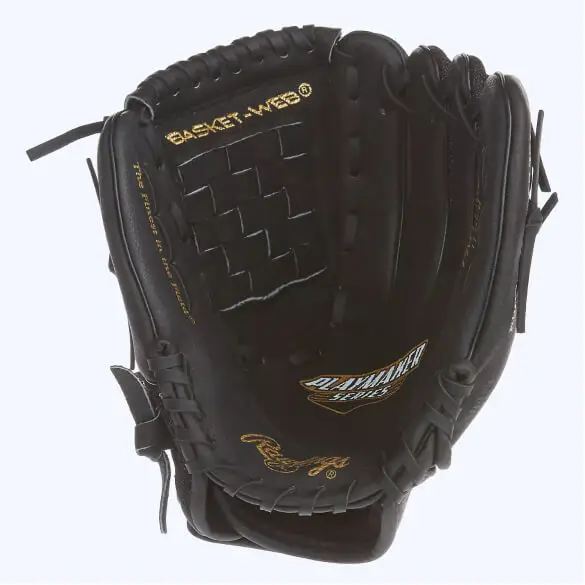
The basket web offers unique versatility, handling fly balls, grounders, and liners with equal aplomb. Its open design allows for quick transfers and a lightweight feel, making it a favorite for agile outfielders who dance across the grass.
Pros:
- Versatile performance: Handles a wide range of outfield situations with ease.
- Lightweight and flexible: Easier to maneuver for younger players and those who value agility.
- Classic look and feel: A timeless design that evokes the golden age of baseball.
Cons:
- Less control for hard-hit balls: The open web might not offer the same level of stability and control as closed webs for screaming liners.
- Not as deep as some other webs: Might not be the best choice for catching high fly balls or grounders bouncing off the wall.
C. Types of Pitcher Baseball Glove Webs
Pitchers rely heavily on deception. To assist pitchers in masking their next throw, the best gloves for the role frequently have a deep pocket and a closed webbing system. The following are the top baseball glove web kinds that we suggest for pitchers:
i. Two-Piece

The two-piece web, with its simple, closed design, is the cornerstone of pitching gloves. It offers unmatched ball control, keeping your fastballs tucked away until the last possible moment, while its impenetrable pocket swallows curveballs whole, leaving hitters flailing at ghosts.
Pros:
- Superb control: The enclosed web keeps your pitches hidden, hindering batters’ ability to pick up spin and location.
- Durable and reliable: The simple design is less prone to tearing or wear and tear, making it a long-lasting companion for countless seasons.
- Great for beginners: The forgiving pocket offers peace of mind, allowing you to focus on developing your pitching mechanics.
Cons:
- Less flexibility: The closed web might restrict your fielding range compared to some open webs.
- Slower transfer: Transferring the ball to your throwing hand might be slightly slower than with open webs.
- Not ideal for quick throws: The deep pocket can slow down throws to first base in pinch situations.
ii. Modified Trapeze
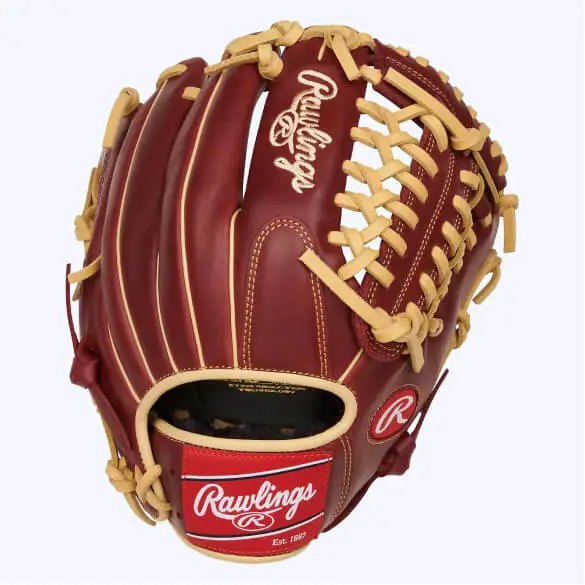
The modified trapeze, with its extra leather strap and deeper pocket, adds a twist to the classic two-piece. It’s designed for pitchers who like to mix things up, keeping hitters guessing with deceptive changes of pace and sneaky off-speed throws.
Pros:
- Enhanced deception: The deeper pocket and extra leather allow for better concealment of your pitch release point.
- Good control for off-speed pitches: The trapeze design provides stability and support for curveballs and changeups.
- Flexible fielding options: The deeper pocket can handle grounders and throws with more ease compared to the classic two-piece.
Cons:
- Bulkier design: The extra leather might feel slightly heavier for some pitchers.
- Reduced visibility: The deeper pocket can slightly limit your view of the hitter and strike zone.
- Can be tricky for beginners: The additional depth might require more practice for mastering control.
iii. Basket Web
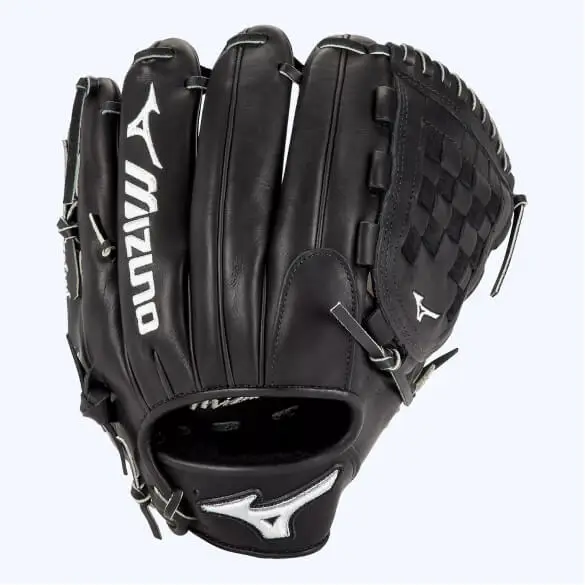
The basket web, with its iconic crisscross pattern, is a throwback to the golden age of pitching, a symbol of legendary hurlers who dominated with raw talent and cunning. It’s all about feel and tradition, offering a secure pocket for your fastball and a deep cradle for your curveball.
Pros:
- Classic look and feel: The timeless design exudes a touch of nostalgia and history.
- Exceptional control for fastballs: The deep pocket and sturdy construction provide unwavering support for your heat.
- Good ball protection: The enclosed web keeps your pitches hidden and protects your hand from hard-hit liners.
Cons:
- Limited visibility: The basket web can significantly restrict your view of the hitter and strike zone.
- Least flexible: The closed design offers the least range of motion for fielding compared to other webs.
- Not ideal for beginners: The deep pocket and lack of visibility might be challenging for developing pitchers to master.
iv. Dual Post
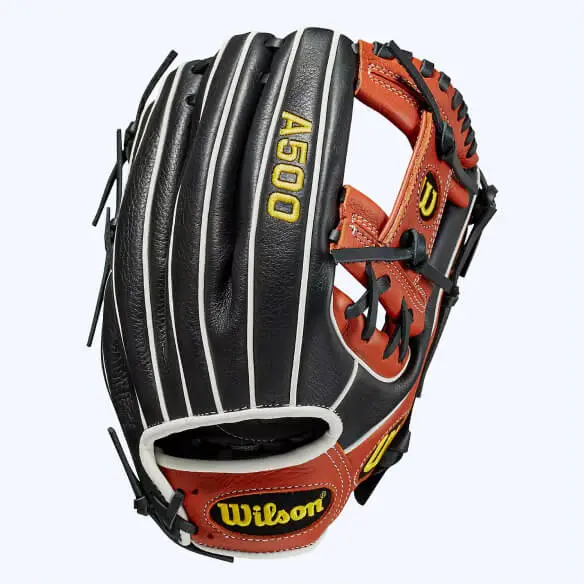
The dual post web, with its two horizontal bars and vertical post, is a modern marvel of pitching technology. It combines the control of a closed web with the visibility of an open one, allowing you to see the hitter while keeping your pitches under wraps. This versatility makes it a favorite for pitchers who like to work both corners of the plate and keep batters on their toes.
Pros:
- Excellent visibility: The open design allows you to see the hitter and strike zone clearly, improving your pitching accuracy.
- Good control for both fastballs and off-speed pitches: The dual post design provides stability for fastballs and support for curveballs and changeups.
- Flexible fielding options: The open web allows for better range of motion and agility compared to fully closed webs, making it easier to field grounders and throws.
Cons:
- Less control for hard-hit balls: The open design might not offer the same level of control as closed webs for screaming liners.
- Bulkier design: The dual post web can feel slightly heavier than some other open web types.
- Not as traditional: The modern design might not appeal to players who prefer the classic look and feel of other web types.
D. Baseball Glove Web Types for Catchers
A catcher’s mitt has shallow, narrow pockets, no fingers, and is thickly padded. They speed up the transfer while lessening the sting and providing catchers with the necessary control. We sell catcher’s mitts based on circumference.
There are two types of closed webbing designs available for catcher’s mitts: half-moon web and one-piece web. Closed web hides your pitch calls while providing catchers with the help they need for those extra-fast deliveries:
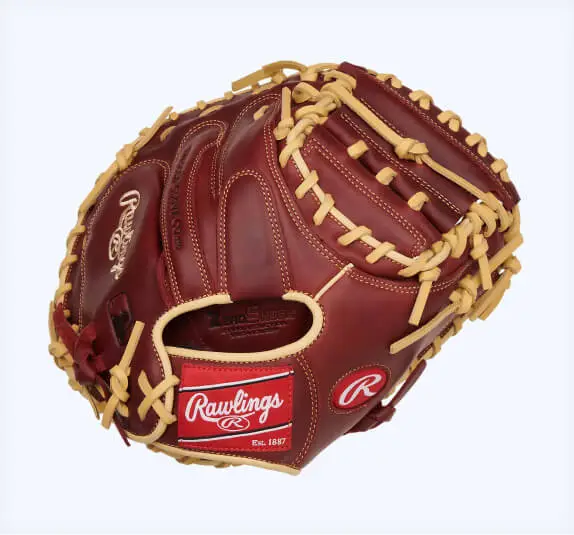
i. Half Moon Web
The Half Moon web, with its two interlocking leather pieces, embodies this defensive spirit. It offers control, trapping fastballs and snagging curveballs with unwavering confidence. The deep pocket swallows up throws from any distance, while the closed design protects your hand from rogue liners.
Pros:
- Superior ball control: The closed web and deep pocket ensure maximum grip and security for even the trickiest pitches.
- Forgiving for beginners: The ample space and secure design make it easier to catch throws, boosting confidence behind the plate.
- Durable construction: The two-piece design offers long-lasting reliability, ideal for rigorous seasons and countless throws.
Cons:
- Limited visibility: The closed web can slightly restrict your view of the batter and strike zone.
- Less flexibility: The deep pocket and sturdy construction might limit your range of motion for fielding ground balls.
- Bulkier feel: The two-piece design can feel heavier than some other web types, requiring more hand strength.
ii. One-Piece Web
The One-Piece web, a single, seamless expanse of leather, is the minimalist masterpiece of catcher’s webs. It’s all about speed and agility, allowing you to react to the play like a lightning strike. The shallow pocket lets you whip the ball out with unmatched speed, while the open design gives you a clear view of the field and batter.
Pros:
- Good visibility: The open web provides a clear line of sight for tracking pitches and reading the batter.
- Lightning-fast transfers: The shallow pocket allows for quick release and throws to second base, ideal for catching baserunners napping.
- Lightweight and flexible: The one-piece design offers exceptional maneuverability and agility, perfect for diving plays and quick reactions.
Cons:
- Less control for inexperienced catchers: The shallow pocket might require more hand strength and skill to secure pitches cleanly.
- Increased risk of passed balls: The open design can be less forgiving of missed throws or mishandled pitches.
- Not ideal for protecting your hand: The open web offers less protection against hard-hit liners compared to closed webs.
E. Types of Baseball Glove Webs for First Basemen
Baseball gloves for first basemen include a long, wide mitt shape that is perfect for managing the difficulties a first baseman has, such as collecting grounders and fielding throws from teammates that resemble missiles in the infield. To ensure that the ball stays in their glove securely, most first baseman will desire deep pockets and some cushioning.
i. The modified H-web
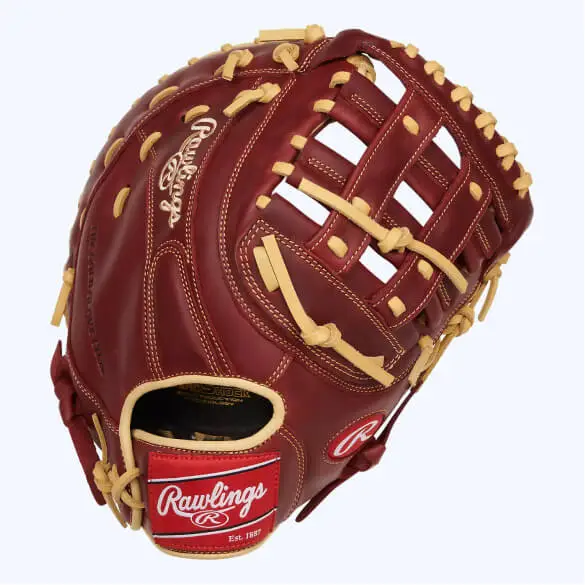
The modified H-web, with its reinforced H-pattern and deeper pocket, is the undisputed king of first base control. It offers the stability of a closed web for snagging hot liners and wild throws, while the deeper pocket swallows up low grounders and scoops throws.
Pros:
- Control: The reinforced H-pattern and deep pocket keep even the wildest throws in check.
- Versatility: Handles everything from screaming liners to slow rollers with ease.
- Durable and reliable: The sturdy construction is built to withstand the rigors of first base play.
Cons:
- Bulkier and heavier: The added material can feel slightly cumbersome compared to other webs.
- Slightly slower transfers: The deep pocket might slow down the transfer time to your throwing hand in close plays.
- Not ideal for beginners: The larger size and weight might be challenging for younger players or those with smaller hands.
ii. Single Post
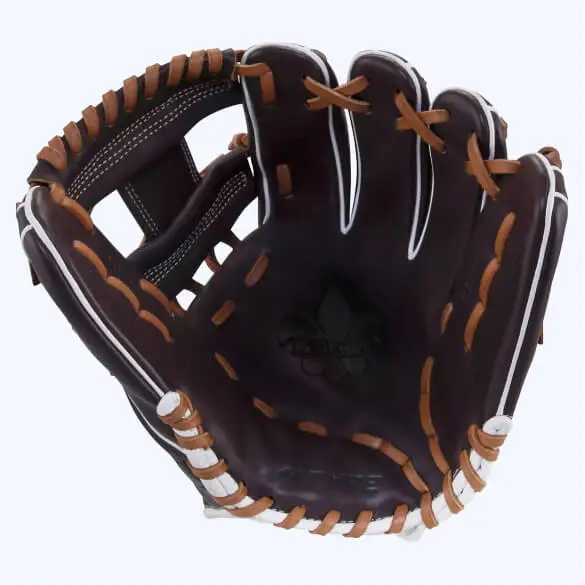
The single post web, with its simple vertical bar and open design, is the agility assassin of first base gloves. It might not offer the same level of control as its closed brethren, but it’s lightweight and flexible design makes it a weapon of choice for quick reflexes and rapid throws.
Pros:
- Lightweight and flexible: Allows for quicker movement and reaction time, ideal for diving plays and throws.
- Good visibility: The open web offers a clear view of the ball and base, improving your fielding awareness.
- Relatively affordable: Often more budget-friendly than other first base web types, making it a good option for beginners.
Cons:
- Less control for hard-hit balls: The open design might not offer the same level of stability for screaming line drives or wild throws.
- Shallow pocket: May not be as effective for scooping low grounders or throws from across the diamond.
- Not ideal for power hitters: Can be challenging to handle the extra force of throws from first basemen with strong arms.
6. Materials for Baseball Gloves
The two most common materials for baseball gloves are synthetic and leather. Which type you select ultimately boils down to personal preference, even if each may have a slight impact on your performance.
- For a shorter break-in period, younger players could use cowhide or synthetic leather.
- Older players could use oil-treated, softened leather gloves for a feel more appropriate for the game.
What really distinguishes leather baseball gloves from synthetic ones, then? We examine each kind of baseball glove material below and provide you with a quick comparison of them:
i. Leather
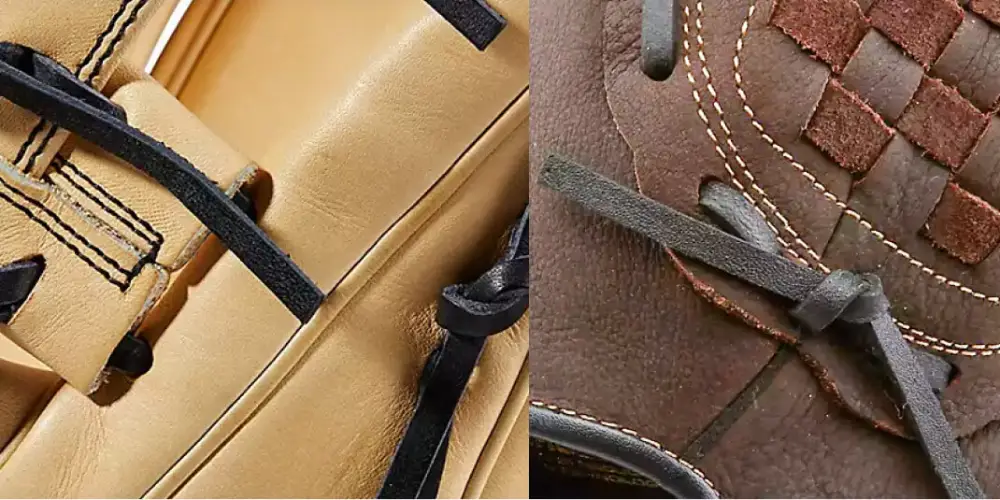
It’s naturally breathable and molds to your hand like a loyal friend, offering unmatched comfort and control. The more you play, the more it develops a unique “pocket”, cradling the ball like a second skin. For serious players, leather’s durability and responsiveness are unparalleled, translating to crisper catches and sharper throws.
Pros:
- Super feel and control: Leather conforms to your hand, providing a natural extension of your body.
- Develops a unique pocket: Over time, leather molds to your playing style, creating a snug and secure fit for the ball.
- Durable and long-lasting: With proper care, leather gloves can last for years, even decades.
- Classic look and feel: Leather exudes a timeless elegance that synthetic simply can’t replicate.
Cons:
- Higher price point: Leather gloves are generally more expensive than their synthetic counterparts.
- Requires break-in: New leather gloves can be stiff and require time and effort to break in.
- High maintenance: Leather needs regular cleaning and conditioning to maintain its quality.
ii. Synthetic
This man-made material has come a long way, offering a lighter, more affordable alternative to leather. Synthetic gloves are often resistant to moisture and weather damage, making them ideal for rainy days or intense practice sessions.
They also break in quickly and require less maintenance, saving you time and effort. However, while some high-end synthetic gloves offer decent grip, they generally lack the natural feel and connection of leather. Additionally, synthetic gloves may not be as durable in the long run, showing wear and tear faster than their leather counterparts.
Pros:
- Affordability: Synthetic gloves are often significantly cheaper than high-quality leather options.
- Lightweight feel: They’re lighter than leather gloves, potentially improving agility and speed on the field.
- Weather resistance: Synthetic materials withstand rain and moisture better than leather.
- Easy maintenance: Generally require minimal cleaning or conditioning.
Cons:
- Less durable: May not last as long as quality leather gloves, especially with heavy use.
- Lower grip: While improving, synthetic gloves often lack the natural grip and feel of leather.
- Less traditional: Some players may prefer the classic look and feel of leather.
7. What Are the Different Parts of a Baseball Glove?

- Web:The section of the glove between your thumb and first finger is called the webbing. Webs, which are composed of densely woven leather components, guarantee reliable ball control and catching.
- Palm: The palm of your glove is the ‘pocket’ that catches the ball in the middle. Beneath the layers of leather, the palms provide safe and protective padding to shield your hand from impact.
- Hinge: Your glove may be easily opened and closed thanks to hinges. More secure catches and ball handling result from this.
- Lacing: The mechanism that secures the glove’s fingers together and gives it the much-needed structure is called the lacing system.
- Wrist adjustment: This adjustable function, which allows the glove to be made tighter or looser, is included in some gloves (typically youth gloves).
Heel: The lower part of the palm side of your gloves is made up of the heel, which is situated just above the place where your hand and wrist connect.
8. Price vs. Performance: A Balancing Act
Remember, the perfect glove is a marriage of your needs and budget. If you’re a beginner or recreational player, a well-made synthetic glove can be a great choice. However, for dedicated players who prioritize durability, performance, and the timeless feel of leather, investing in a high-quality full-grain glove is a worthwhile commitment. Ultimately, the material you choose should reflect your playing style, budget, and personal preferences.
Ultimately, the material choice is a personal odyssey. Weigh your priorities, consider your budget, and most importantly, listen to your gut. Whether you choose the rugged charm of leather or the modern appeal of synthetic, remember, the perfect glove is the one that sparks joy in your heart and empowers you to conquer the diamond!
Conclusions
The perfect glove isn’t a one-size-fits-all. Whether you’re a slick infielder with lightning transfers or a cunning pitcher weaving spells with your pitches, there’s a web out there waiting to unleash your inner baseball beast. Consider your position, playing style, and experience when making your choice. Remember, the glove is an extension of yourself, so pick one that speaks to your unique swagger on the diamond. Now, get out there, snag some fly balls, turn double plays, and show the world what you’re made of! And hey, if you’re having trouble deciding or have some fielding wisdom to share, drop a comment below! Let’s keep the baseball conversation going!
FAQs
Q: How do I choose a good baseball glove?
A: Fit and position are key! Measure your hand and choose a glove size that fits snugly (not too big or too small). Consider your position and playing style: Infielder? Go for an open web for quick transfers. Outfielder? A deep pocket for catching fly balls. Pitcher? Closed web for control and deception.
Q: Why are there different types of baseball gloves?
A: Different webs and sizes serve different purposes! Open webs allow for fast transfers, closed webs give better control, and deeper pockets provide more security for catching. Sizes vary for age, hand size, and position (e.g., outfielders need larger gloves).
Q: What is a normal glove size?
A: It depends on age and hand size, but generally:
- Youth (5-7 years): 9.5 – 10.5 inches
- Youth (8-12 years): 10.75 – 11.75 inches
- Teenagers/Adults (infield): 11.25 – 12.25 inches
- Teenagers/Adults (outfield): 12.5 – 13.5 inches
